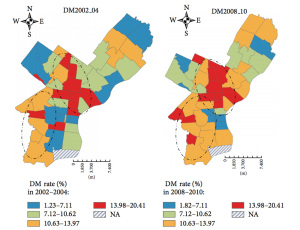
In the competition for highest diabetes rate among the nation’s largest cities Philadelphia currently takes gold. Between the years 2002 and 2010, Drexel associate professors Longjian Liu and Ana Nunez, collected data monitoring the relationship between an individual’s neighborhood and its risk of contracting diabetes.
At first glance, it might seem strange to monitor entire communities for what seems to be an individual disease. But diabetes typically arises as a part of one’s lifestyle choices — namely diet and exercise. Local environment influences a great number of such day-to-day choices.
“We previously have looked at just individuals behavior to ask them to change their behavior,” Liu, lead author on the study, explained. “Stop smoking. Increase physical activity. Lifestyle changes.”
“If you just improve the location you can benefit all. Not just people who already have the disease,” Liu continued.
The research was published Nov. 6. Liu and Nunez’s conclusions found that living in an underprivileged community increases probability of developing diabetes an additional 12 percent compared to otherwise like individuals. As well, the frequency of adults 18 and older in the city developing diabetes significantly increased from 2002 to 2010.
They used a survey by the Public Health Management Cooperation to ask 17,000 participants living in 46 Philadelphia ZIP codes questions about their personal health. Things like: if they are overweight, what kind of physical activity do they usually get and how many servings of fruits and vegetables they have a day.
Nunez explained the composition of factors that might affect one’s chances of developing diabetes: “The composition is your genetics, your environment and how you live. Those are sort of the three things,” she said.
Where people live impacts their access to healthy food, exercise facilities and other factors that can dramatically impact their wellness.
“If you can go out for a walk or a bike ride you probably will. But if you live in a neighborhood where that’s really not safe then you’re probably not going to go out for a walk,” Nunez explained. “So the suggestion of ‘walk more’ to reduce your weight isn’t going to work based on where you live. Even some of the lifestyle options that people have to take care of themselves aren’t really feasible if they live in environments that can’t support doing those things.”
Liu and Nunez ranked each ZIP code they studied in Philadelphia based on a “Physical and Social Environment” rating. An area’s rating was based on people’s answers to the questions about various health issues.
The PSE rankings were wide-ranging. Depending on the PSE rating of the neighborhood, risk of developing diabetes increased or decreased correspondingly. The worse the PSE rating, the higher chance an individual had of developing diabetes.
“What this suggests is that people who have borderline risk of having diabetes who are in environments that have that drag, are going to have earlier diabetes or get diabetes compared to someone who doesn’t necessarily have that same environmental influence,” Nunez said.
Changing an area’s access to fresh produce, exercise facilities or improving the neighborhood’s overall safety as to provide a safe outdoor environment could improve the health of the entire community.
“In an ideal world collectively as citizens we have to say, ‘look we want our population to be healthy and so we have to have healthy communities. We have to invest in terms of having places where people can walk and exercise. Safe lighting, [other] things like that. As well as opportunities,’” Nunez continued.
Focusing on the health of the community rather than the health of the individuals within it could improve overall health. Simply increasing living conditions could lower health care costs long term.
“As a government you want to think about health, not business. You want a healthy Philadelphia. Not a sick Philadelphia,” Liu said.
The study supports that reducing risk at the community level would show a great deal of promise in terms of reducing risk of diabetes and other diseases that are often lifestyle dependent.


